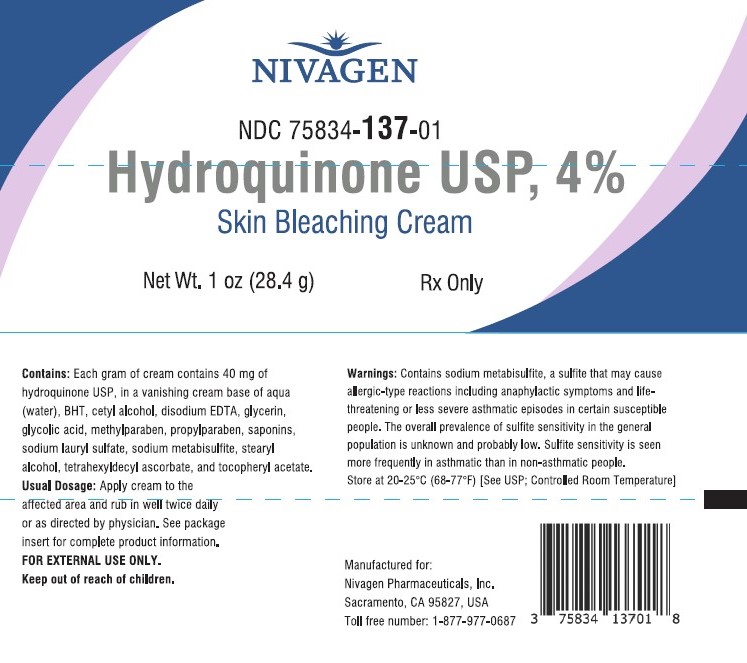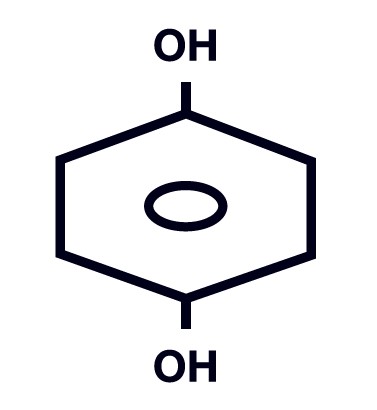Hydroquinone 4%
HYDROQUINONE 4% CREAM Skin Bleaching Cream Rx Only FOR EXTERNAL USE ONLY NOT FOR OPHTHALMIC USE
7844c308-e0a2-42e7-bd28-f68a59ebca83
HUMAN PRESCRIPTION DRUG LABEL
Feb 7, 2024
Nivagen Pharmaceuticals, Inc.
DUNS: 052032418
Products 1
Detailed information about drug products covered under this FDA approval, including NDC codes, dosage forms, ingredients, and administration routes.
Hydroquinone
Product Details
FDA regulatory identification and product classification information
FDA Identifiers
Product Classification
Product Specifications
INGREDIENTS (14)
Drug Labeling Information
PACKAGE LABEL.PRINCIPAL DISPLAY PANEL
PACKAGE LABEL.PRINCIPAL DISPLAY PANEL
28.4 g Tube Carton
****
INDICATIONS & USAGE SECTION
INDICATIONS & USAGE
Hydroquinone USP, 4% Skin Bleaching Cream is indicated for the gradual bleaching of hyperpigmented skin conditions such as chloasma, melasma, freckles, senile lentigines, and other unwanted areas of melanin hyperpigmentation.
CONTRAINDICATIONS SECTION
CONTRAINDICATIONS
Prior history of sensitivity or allergic reaction to hydroquinone or to any of the ingredients of the product. The safety of topical hydroquinone use during pregnancy or for children (12 years and under) has not been established.
ADVERSE REACTIONS SECTION
ADVERSE REACTIONS
The following adverse reactions have been reported: dryness and fissuring of
paranasal and infraorbital areas, erythema, and stinging.
Occasional hypersensitivity (localized contact dermatitis) may develop. If
this occurs, the medication should be discontinued and the physician notified
immediately.
CLINICAL PHARMACOLOGY SECTION
CLINICAL PHARMACOLOGY
Topical application of hydroquinone produces a reversible depigmentation of the skin by inhibition of the enzymatic oxidation of tyrosine to 3,4-dihydroxyphenylalanine (dopa) (Denton, C. et al., 1952)1 and suppression of other melanocyte metabolic processes (Jimbow, K. et al., 1974)2. Exposure to sunlight or ultraviolet light will cause repigmentation of bleached areas (Parrish, J.A. et al., 1978)3.
WARNINGS SECTION
WARNINGS
Contains sodium metabisulfite, a sulfite that may cause allergic-type reactions including anaphylactic symptoms and life-threatening or less severe asthmatic episodes in certain susceptible people. The overall prevalence of sulfite sensitivity in the general population is unknown and probably low. Sulfite sensitivity is seen more frequently in asthmatic than in non-asthmatic people. Since this product contains no sunscreen, an effective broad spectrum sun blocking agent should be used and unnecessary solar exposure avoided, or protective clothing should be worn to cover bleached skin in order to prevent repigmentation from occurring. Hydroquinone may produce exogenous ochronosis, a gradual blue-black darkening of the skin. If this condition occurs, discontinue treatment and consult your physician. The majority of patients developing this condition are Black, but it may also occur in Caucasians and Hispanics.
OVERDOSAGE SECTION
OVERDOSAGE
There have been no systemic reactions reported from the use of topical hydroquinone. However, treatment should be limited to relatively small areas of the body at one time, since some patients experience a transient skin reddening and a mild burning sensation which does not preclude treatment.
DOSAGE & ADMINISTRATION SECTION
DOSAGE & ADMINISTRATION
Hydroquinone USP, 4% Skin Bleaching Cream should be applied to affected areas and rubbed in well twice daily, in the morning and before bedtime, or as directed by a physician. If no improvement is seen after 2 months of treatment, use of this product should be discontinued. There is no recommended dosage for pediatric patients under 12 years of age except under the advice and supervision of a physician.
HOW SUPPLIED SECTION
HOW SUPPLIED
Hydroquinone USP, 4% Skin Bleaching Cream is available as follows:
1 oz (28.4 g) tube (NDC 75834-137-01)
STORAGE
Hydroquinone USP, 4% Skin Bleaching Cream should be stored at controlled room
temperature (20-25°C) (68-77°F). Darkening of this product is normal.
This will not affect performance or safety.
All prescription substitutions and/or recommendations using this product shall be made subject to state and federal statutes as applicable.** Please **NOTE: This is not an Orange Book product and has not been subjected to FDA therapeutic or other equivalency testing. No representation is made as to generic status or bioequivalency. Each person recommending a prescription substitution using this product shall make such recommendation based on his/her professional knowledge and opinion, upon evaluating the active ingredients, inactive ingredients, excipients and chemical information provided herein.
REFERENCES
1 DENTON C., LERNER A.B., FITZPATRICKT.B.
Inhibition of Melanin Formation by Chemical Agents
Journal of Investigative Dermatology 1952, 18:119-135.
2 JIMBOW K., OBATA H., PATHAK M., FITZPATRICK T.B.
Mechanism of Depigmentation by Hydroquinone
Journal of Investigative Dermatology 1974, 62:436-449.
3 PARRISH J.A., ANDERSON R.R., URBACH F., PITTS D.
UVA, Biological Effects of Ultraviolet Radiation with Emphasis on Human
Responses to Longwave Ultraviolet
Plenum Press, New York and London, 1978, p. 151.
Manufactured for:
** Nivagen Pharmaceuticals, Inc.**
** Sacramento, CA 95827 USA**
** Toll free number: 1-877-977-0687**
Rev. 02/2022
Hydroquinone USP, 4%
Skin Bleaching Cream
DESCRIPTION SECTION
DESCRIPTION
Each gram of Hydroquinone USP, 4% Skin Bleaching Cream contains 40 mg of hydroquinone USP, in a vanishing cream base of aqua (water), BHT, cetyl alcohol, disodium EDTA, glycerin, glycolic acid, methylparaben, propylparaben, saponins, sodium lauryl sulfate, sodium metabisulfite, stearyl alcohol, tetrahexyldecyl ascorbate, and tocopheryl acetate. Chemically, hydroquinone is C6H6O2 and has a molecular weight of 110.11. The chemical name is 1,4 dihydroxybenzene, and the structural formula of hydroquinone is:

PRECAUTIONS SECTION
PRECAUTIONS
(see WARNINGS)
GENERAL PRECAUTIONS
Test for skin sensitivity before using by applying a small amount to an
unbroken patch of skin; check within 24 hours. Minor redness is not a
contraindication, but where there is itching or vesicle formation or excessive
inflammatory response further treatment is not advised. Close patient
supervision is recommended.
Hydroquinone is a skin bleaching agent which may produce unwanted cosmetic
effects if not used as directed. The physician should be familiar with the
contents of this insert before prescribing or dispensing this medication.
INFORMATION FOR PATIENTS
Sunscreen use is an essential aspect of hydroquinone therapy because even
minimal sunlight sustains melanocytic activity. To prevent repigmentation,
during treatment and maintenance therapy, sun exposure on treated skin should
be avoided by application of a broad spectrum sunscreen (SPF 15 or greater) or
by use of protective clothing.
Avoid contact with eyes and mucous membranes.
Keep this and all medications out of reach of children. In case of accidental
ingestion, call a physician or a poison control center immediately.
DRUG INTERACTIONS
Patients are cautioned on concomitant use of medications that are known to be photosensitizing.
CARCINOGENESIS & MUTAGENESIS & IMPAIRMENT OF FERTILITY
Studies of hydroquinone in animals have demonstrated some evidence of
carcinogenicity. The carcinogenic potential of hydroquinone in humans is
unknown.
Published studies have demonstrated that hydroquinone is a mutagen and a
clastogen. Treatment with hydroquinone has resulted in positive findings for
genetic toxicity in the Ames assay in bacterial strains sensitive to oxidizing
mutagens, in in vitro studies in mammalian cells, and in the in vivo mouse
micronucleus assay.
PREGNANCY
Teratogenic Effects: Pregnancy Category C -
Animal reproduction studies have not been conducted with topical hydroquinone.
It is also not known whether topical hydroquinone can cause fetal harm when
administered to a pregnant woman or can affect reproduction capacity. Topical
hydroquinone should be given to a pregnant woman only if clearly needed.
NURSING MOTHERS
It is not known whether this drug is excreted in human milk. Because many drugs are excreted in human milk, caution should be exercised when topical hydroquinone is administered to a nursing woman.
PEDIATRIC USE
Safety and effectiveness for pediatric patients below the age of 12 years have not been established.
